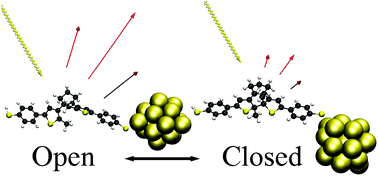Controlling the non-resonant chemical mechanism of SERS using a molecular photoswitch
Abstract
In this work we present a detailed investigation of the Raman properties of a dithienylethene photoswitch interacting with a small gold cluster (Au19+) using time-dependent density functional theory (TD-DFT). The enhancement mechanism (CHEM) due to the molecule–surface chemical coupling in surface-enhanced Raman scattering (![[small omega, Greek, macron]](https://www.rsc.org/images/entities/i_char_e0da.gif) e)4, where ωX is the HOMO–LUMO gap of the free molecule and
e)4, where ωX is the HOMO–LUMO gap of the free molecule and ![[small omega, Greek, macron]](https://www.rsc.org/images/entities/i_char_e0da.gif) e is an average excitation between the HOMO of the photoswitch and the LUMO of the metal. We propose that the ability of this photoswitch to switch reversibly from open to closed will make it an excellent probe to control the CHEM enhancement of
e is an average excitation between the HOMO of the photoswitch and the LUMO of the metal. We propose that the ability of this photoswitch to switch reversibly from open to closed will make it an excellent probe to control the CHEM enhancement of

- This article is part of the themed collections: New frontiers in Surface-Enhanced Raman Scattering and Web Collection: Surface-Enhanced Raman Scattering (SERS)

 Please wait while we load your content...
Please wait while we load your content...